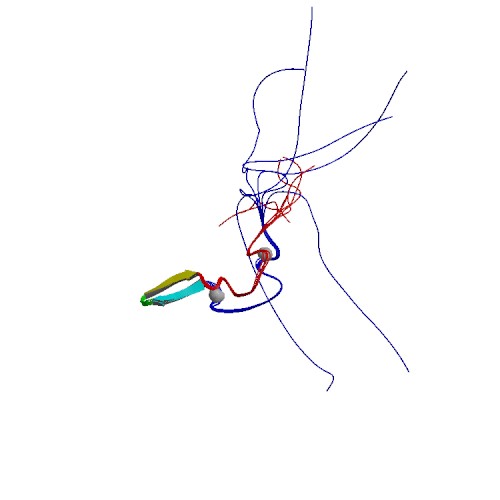DNAJA3: Difference between revisions
Jump to navigation
Jump to search
m (Robot: Automated text replacement (-{{WikiDoc Cardiology Network Infobox}} +, -<references /> +{{reflist|2}}, -{{reflist}} +{{reflist|2}})) |
(No difference)
|
Revision as of 15:50, 4 September 2012
| DnaJ (Hsp40) homolog, subfamily A, member 3 | |||||||||||||
|---|---|---|---|---|---|---|---|---|---|---|---|---|---|
 PDB rendering based on 2ctt. | |||||||||||||
| |||||||||||||
| Identifiers | |||||||||||||
| Symbols | DNAJA3 ; FLJ45758; TID1; hTid-1 | ||||||||||||
| External IDs | Template:OMIM5 Template:MGI HomoloGene: 36170 | ||||||||||||
| |||||||||||||
| RNA expression pattern | |||||||||||||
 | |||||||||||||
| More reference expression data | |||||||||||||
| Orthologs | |||||||||||||
| Template:GNF Ortholog box | |||||||||||||
| Species | Human | Mouse | |||||||||||
| Entrez | n/a | n/a | |||||||||||
| Ensembl | n/a | n/a | |||||||||||
| UniProt | n/a | n/a | |||||||||||
| RefSeq (mRNA) | n/a | n/a | |||||||||||
| RefSeq (protein) | n/a | n/a | |||||||||||
| Location (UCSC) | n/a | n/a | |||||||||||
| PubMed search | n/a | n/a | |||||||||||
DnaJ (Hsp40) homolog, subfamily A, member 3, also known as DNAJA3, is a human gene.
DNAJA3 belongs to the evolutionarily conserved DNAJ/HSP40 family of proteins. For background information on the DNAJ family, see MIM 608375.[supplied by OMIM][1]
References
Further reading
- Maruyama K, Sugano S (1994). "Oligo-capping: a simple method to replace the cap structure of eukaryotic mRNAs with oligoribonucleotides". Gene. 138 (1–2): 171–4. PMID 8125298.
- Suzuki Y, Yoshitomo-Nakagawa K, Maruyama K; et al. (1997). "Construction and characterization of a full length-enriched and a 5'-end-enriched cDNA library". Gene. 200 (1–2): 149–56. PMID 9373149.
- Schilling B, De-Medina T, Syken J; et al. (1998). "A novel human DnaJ protein, hTid-1, a homolog of the Drosophila tumor suppressor protein Tid56, can interact with the human papillomavirus type 16 E7 oncoprotein". Virology. 247 (1): 74–85. doi:10.1006/viro.1998.9220. PMID 9683573.
- Syken J, De-Medina T, Münger K (1999). "TID1, a human homolog of the Drosophila tumor suppressor l(2)tid, encodes two mitochondrial modulators of apoptosis with opposing functions". Proc. Natl. Acad. Sci. U.S.A. 96 (15): 8499–504. PMID 10411904.
- Shinohara M, Gasior SL, Bishop DK, Shinohara A (2000). "Tid1/Rdh54 promotes colocalization of rad51 and dmc1 during meiotic recombination". Proc. Natl. Acad. Sci. U.S.A. 97 (20): 10814–9. PMID 11005857.
- Trentin GA, Yin X, Tahir S; et al. (2001). "A mouse homologue of the Drosophila tumor suppressor l(2)tid gene defines a novel Ras GTPase-activating protein (RasGAP)-binding protein". J. Biol. Chem. 276 (16): 13087–95. doi:10.1074/jbc.M009267200. PMID 11116152.
- Ohtsuka K, Hata M (2001). "Mammalian HSP40/DNAJ homologs: cloning of novel cDNAs and a proposal for their classification and nomenclature". Cell Stress Chaperones. 5 (2): 98–112. PMID 11147971.
- Sarkar S, Pollack BP, Lin KT; et al. (2002). "hTid-1, a human DnaJ protein, modulates the interferon signaling pathway". J. Biol. Chem. 276 (52): 49034–42. doi:10.1074/jbc.M103683200. PMID 11679576.
- Yin X, Rozakis-Adcock M (2002). "Genomic organization and expression of the human tumorous imaginal disc (TID1) gene". Gene. 278 (1–2): 201–10. PMID 11707338.
- Cheng H, Cenciarelli C, Shao Z; et al. (2002). "Human T cell leukemia virus type 1 Tax associates with a molecular chaperone complex containing hTid-1 and Hsp70". Curr. Biol. 11 (22): 1771–5. PMID 11719219.
- Cheng H, Cenciarelli C, Tao M; et al. (2002). "HTLV-1 Tax-associated hTid-1, a human DnaJ protein, is a repressor of Ikappa B kinase beta subunit". J. Biol. Chem. 277 (23): 20605–10. doi:10.1074/jbc.M201204200. PMID 11927590.
- Wang Y, Han KJ, Pang XW; et al. (2002). "Large scale identification of human hepatocellular carcinoma-associated antigens by autoantibodies". J. Immunol. 169 (2): 1102–9. PMID 12097419.
- Sasaki S, Nakamura T, Arakawa H; et al. (2002). "Isolation and characterization of a novel gene, hRFI, preferentially expressed in esophageal cancer". Oncogene. 21 (32): 5024–30. doi:10.1038/sj.onc.1205627. PMID 12118383.
- Strausberg RL, Feingold EA, Grouse LH; et al. (2003). "Generation and initial analysis of more than 15,000 full-length human and mouse cDNA sequences". Proc. Natl. Acad. Sci. U.S.A. 99 (26): 16899–903. doi:10.1073/pnas.242603899. PMID 12477932.
- Syken J, Macian F, Agarwal S; et al. (2003). "TID1, a mammalian homologue of the drosophila tumor suppressor lethal(2) tumorous imaginal discs, regulates activation-induced cell death in Th2 cells". Oncogene. 22 (30): 4636–41. doi:10.1038/sj.onc.1206569. PMID 12879007.
- Rodriguez M, Yu X, Chen J, Songyang Z (2004). "Phosphopeptide binding specificities of BRCA1 COOH-terminal (BRCT) domains". J. Biol. Chem. 278 (52): 52914–8. doi:10.1074/jbc.C300407200. PMID 14578343.
- Ota T, Suzuki Y, Nishikawa T; et al. (2004). "Complete sequencing and characterization of 21,243 full-length human cDNAs". Nat. Genet. 36 (1): 40–5. doi:10.1038/ng1285. PMID 14702039.
- Lo JF, Hayashi M, Woo-Kim S; et al. (2004). "Tid1, a cochaperone of the heat shock 70 protein and the mammalian counterpart of the Drosophila tumor suppressor l(2)tid, is critical for early embryonic development and cell survival". Mol. Cell. Biol. 24 (6): 2226–36. PMID 14993262.
- Edwards KM, Münger K (2004). "Depletion of physiological levels of the human TID1 protein renders cancer cell lines resistant to apoptosis mediated by multiple exogenous stimuli". Oncogene. 23 (52): 8419–31. doi:10.1038/sj.onc.1207732. PMID 15156195.
- Colland F, Jacq X, Trouplin V; et al. (2004). "Functional proteomics mapping of a human signaling pathway". Genome Res. 14 (7): 1324–32. doi:10.1101/gr.2334104. PMID 15231748.
| This protein-related article is a stub. You can help Wikipedia by expanding it. |